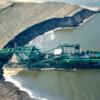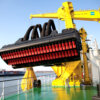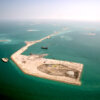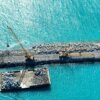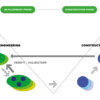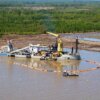The design of a reclamation area is directly related to the performance requirements for the intended use of the area, within various boundary conditions.
Iterative Design Philosophy
The design philosophy should be based on a calculated process of matching the anticipated loading response of the fill mass to the requirements imposed by the future use of the reclaimed land. This takes place within the technical boundary conditions of the project. Clearly, the function of a beach nourishment differs from that of a reclamation area intended to accommodate an airport or a container terminal. Consequently, the corresponding technical specifications resulting from the design process will also differ. This philosophy must ensure that reclamation is not over-designed and that geotechnical specifications are reasonable, measurable and feasible.
An essential element of the design philosophy is an iterative design procedure: this means that during the development process the structural design of the superstructures may have to be re-considered.
Boundary conditions
Once the functional requirements of a fill are defined, an adequate inventory of all boundary conditions has to be made. Boundary conditions may be external, often uncontrollable conditions that could affect the performance of the hydraulic fill including the quality and quantity of the fill material available, the nature of soils underlying the future fill area, earthquakes and other natural hazards, tides and waves.
Construction methods
Usually the contractor selects or proposes the most cost-effective and suitable construction method to realise the fill mass properties according to the performance requirements and within the boundary conditions. It is essential, however, that the designer of a hydraulic fill also has a thorough understanding of the possibilities and limitations of the various construction methods including dredging and reclamation operations and soil improvement techniques.
Design cycle
The design of the fill mass is one part of the design cycle of a total project. The design of the total project follows these steps:
- define functional requirements of fill mass;
- define performance requirements of fill mass;
- determine boundary conditions;
- choose construction method;
- based on the above, create technical design;
- evaluate feasibility of design including timing, risks and quality control;
- establish the technical specifications.
If it not be possible to identify a construction method (and – if required – a soil improvement technique) that results in a fill mass that meets the specified performance requirements without excessive costs, the engineer may have to reconsider the starting points of the fill design.
This will generally imply adjustments of the design of the superstructures resulting in adapted performance requirements.
Design changes
Design changes of the structures may include modifications to foundations, slope angles, drainage facilities and/or revetments, alterations of final grade levels, the introduction of soil retaining structures, and other aspects.
Whether to apply a soil improvement technique or to adjust the design of the superstructures may often be decided on the basis of costs, but technical feasibility and low failure probability may be important criteria as well.
Soil improvement methods include techniques such as surcharging (in combination with vertical drains), compaction, deep soil mixing and vibro replacement.
Economics and technical feasibility of the reclamation and soil improvement techniques may affect the geometry of a reclamation area as well. Long pumping distances, for instance, may result in the need for a booster pump station. Adjustment of the geometry of the proposed reclamation area could reduce the pumping distance and, hence, lower the costs.


